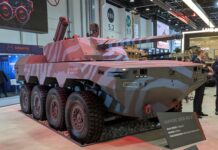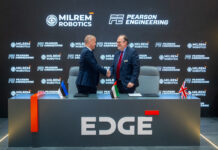
Rise of the Robot Warrior
Doug Richardson
An early military application of robotic technology was the creation of Unmanned Ground Vehicles (UGVs) for Explosive Ordnance Demolition (EOD) tasks. More recently, robotic systems have been used for short-range reconnaissance, particularly during urban-combat operations. Arming robotic platforms with weapons intended for use against enemy personnel, vehicles or other point targets, is the latest development.
Much reduced in size from the 364,000 soldiers it fielded in 1950, the British Army currently numbers around 82,000, a modest figure not seen since the closing years of the 18th century. Speaking to the Sky News television channel in November 2020, UK Chief of Defence Staff General Sir Nick Carter predicted that by the 2030s, the British Army might have around 120,000 soldiers, but about a quarter of these could be robots.
UGVs can make soldiers more effective, and reduce the casualty rate. One possible role is to operate several kilometres ahead of friendly forces, detecting and engaging the enemy, and providing the tactical information that will allow units to advance and conduct an effective operation. UGVs may prove particularly effective in urban warfare, while the ability to accept robotic ‘casualties’ may help ground units to deal with the human-shield tactics sometimes used by irregular forces.
Remote-Controlled Robots
The simplest method of creating a UGV is to adapt an existing manned vehicle for remotely-controlled use. In 2019, the UK announced that some Army fighting vehicles would be fitted with a remote-control capability, so they can be sent ahead of manned vehicles to test the reactions and combat strength of enemy defences. Russia’s VIHR (Hurricane) is another example of an adapted vehicle. It is based on the chassis of the BMP-3 armoured fighting vehicle, so can exploit existing maintenance and repair facilities. However, this approach results in a large and heavy system, given that the chassis was originally intended to house a crew.
Most UGVs use a custom-designed wheeled or tracked chassis. This in normally powered by one or more electric motors, a small internal combustion engine, or a combination of the two. Most current designs rely on remote control via a radio or fibre-optic link. Some have a semi-autonomous navigational ability intended to reduce the operator’s workload.
During research for this article, the author looked at the specifications of more than 100 UGVs currently being marketed, or known to be under development, for which a combat role is claimed. Such numbers make it impossible to describe more than a handful within the confines of a magazine article.
US Robotic Programmes
Developed by Foster-Miller for the US Army, the Special Weapons Observation Reconnaissance Detection System (SWORDS) was a weaponised version of the company’s TALON remotely operated vehicle. Designed to carry armament ranging from an M16 rifle to a 40mm grenade launcher or a 66mm M202A1 FLASH (FLame Assault SHoulder) incendiary weapon, it was deployed to Iraq in 2017 in three examples of a variant armed with a Squad Automatic Weapon (SAW) M249 machine gun. These may have seen limited use in surveillance and peacekeeping/guard operations, but were soon withdrawn.
By 2021, the US Army had around 20 robotics programmes underway. One of the most important is the Robotic Combat Vehicle programme. This envisages light (under 10 tons), medium (under 15 tons), and heavy weight (20-25 tons) robotic vehicles able to be integrated with a range of payloads able to meet future requirements. These could include high-resolution long-range targeting sensors, as well as weaponry ranging from machine guns to antitank missiles. Artificial intelligence (AI) technology could allow target data to be automatically processed, then transmitted to army ground-based units and to airborne assets such as attack helicopters, armed UAVs, and close-support aircraft.
Textron Systems and QinetiQ have been awarded contracts to build light and medium weight platforms. In November 2020, QinetiQ Inc. and Pratt Miller Defense delivered the first of four Robotic Combat Vehicle – Light (RCV-L) to the Ground Vehicle Systems Center (GVSC) of the US Army Combat Capabilities Development Command (CCDC). It combines the Pratt Miller Expeditionary Modular Autonomous Vehicle (EMAV) and with QinetiQ’s Modular Open System Architecture (MOSA) robotic control systems, and was designed to be payload-agnostic. Early in 2021, Textron Systems and Howe & Howe delivered the fourth and final RIPSAW M5 medium-weight robotic vehicle to the US Army.
To supplement these vehicles, the US Army has modified four M113 armoured personnel carriers to act as RCV surrogates. All three types, plus Mission Enabling Technologies Demonstrators (MET-D) configured to serve as RCV control vehicles, will take part in a Soldier Operational Experiment (SOE) planned for 2022. The experience gained should allow further refinements to be made to the prototype and surrogate vehicles before the programme begins a Phase III cycle expected to include an SOE tentatively planned for FY26.
Russian Developments
Russia has developed many models of UGV, and made limited use of its URAN-9 in Syria. Created by JSC 766 UPTK, this is a tracked vehicle weighing around 12 tons, and carries a turret armed with a 30mm 2A72 cannon, a 7.62mm coaxial machinegun, and four 9M120-1 ATAKA anti-tank guided missiles. Combat use of the vehicle in Syria showed many problems. Control of the URAN-9 is via a radio-based datalink, but this proved unreliable, allowing the vehicle to operate at ranges of only some 500 m from its manned control station. Communications dropouts were not uncommon.
The sensors and armament were not stabilised to allow their use when the vehicle was on the move, so the URAN-9 had to stop in order to use them. When a command to fire was sent, on six occasion there was a time lag in the response, and on one occasion the vehicle did not fire. Reliability problems were also experienced with the armament and suspension system. These poor results probably triggered a programme of modifications. By 2019, URAN-9 had been accepted for service by the Russian military, and series production had begun.
Milrem’s Developments
The UK’s Project Theseus is intended to develop and field-test autonomous logistic resupply systems. It will use three Horiba MIRA VIKING 6×6 all-terrain UGVs able to carrying up to 750 kg of supplies to frontline troops. These vehicles will use AI to allow navigation in GPS-denied situations. The Estonian company Milrem Robotics will supply two further UGVs to QinetiQ, which will install autonomous functions in these vehicles before delivering them for trials.
Milrem Robotics has developed many versions of its Tracked Hybrid Modular Infantry System (THeMIS). These share a common basic configuration consisting of two tracked propulsion assemblies positioned on opposite sides of a central platform. All the hardware for the hybrid diesel-electric drive is located within the propulsion assemblies, leaving the central platform free for mission-specific equipment. This layout simplifies the task of creating new variants, and a series of these have been displayed at recent defence exhibitions.
As its designation suggests, the Tracked Hybrid Modular Infantry System (THeMIS) ADDER uses the Singapore Technologies Kinetics ADDER remote weapons station armed with a two-axis stabilised single or dual weapon, ranging from 7.62mm machine gun to a 40mm automatic grenade launcher.
Developed in conjunction with Kongsberg Defence, THeMIS PROTECTOR can carry armament ranging from a machine gun to a JAVELIN anti-tank missile system. Perhaps the most ambitious member of the family is that which carries an MBDA Integrated MMP Precision Attack Combat Turret (IMPACT) fitted with two MPP fire-and-forget antitank missiles and the associated fire-control system, plus a 7.62mm machine gun. A two-way datalink allows man-in-the-loop control of the missile.
Anyone catching a distant glimpse of Milrem Robotics’ new TYPE-X Combat UGV can be excused for mistaking it for an obsolete British CENTURION Main Battle Tank (MBT). But despite this resemblance, the company’s latest creation weighs only 12 tons. Developed to support mechanised units and MBTs, it can use a turret-mounted autocannon of 25-50mm calibre to engage lower-range targets.
A second variant of the TYPE-X can be fitted with a Multi Canister Launcher for two UVision Loitering Munition Systems – either the HERO-120 with and anti-tank warhead and a flight time of up to one hour, or the HERO-400EC capable of destroying fortified targets, and remaining airborne for up to two hours.
Two types of control system are currently offered – remote control, and waypoint navigation. ‘Follow me’ guidance is currently under development, as is a swarming capability. An optional telescopic rising mast carrying the communication antenna will allow remote control at ranges of up to 40 km.
In May 2021 the IDF announced that it had deployed the Israeli Aerospace Industries JAGUAR 1.5-ton unmanned wheeled ground vehicle as part of its border defences around Gaza. The vehicle is reported to be semi-autonomous in that it can use AI to manoeuvre around obstacles along its programmed route, or to go to a recharging point when its power level is low. Turret-mounted electro-optical and thermal sensors can detect humans, but the decision to engage these with the turret-mounted 7.62mm machine gun is taken by a human operator. Final aiming and fire-adjustment are reportedly handled by an AI subsystem.
Four Turkish companies are competing to offer a medium-class tracked UGV to their country’s armed forces – Aselsan with the ASLAN (Lion) UGV, Best Group with the FEDAI (Bodyguard), Elektroland Defence with its HANCER (Dagger), and Havelsan with the BARKAN. All are armed with Aselsan’s SARP, a remote-controlled weapon system able to mount a 7.62mm or 12.7mm machine gun or a 40mm grenade launcher.
Autonomous UGVs
The prospect of autonomous UGVs able to use AI to provide independent decision-making in the use of weapons has attracted concern by organisations such as Amnesty International, Human Rights Watch, and the International Committee for Robot Arms Control, but any visitor to a defence exhibition who goes in search of what some opponents of the concept term ‘killerbots’ or ‘slaughterbots’ is likely to achieve little beyond the expenditure of time and shoe leather. During research for this article, the author looked at the specifications of more than 100 UGVs currently being marketed, or known to be under development, for which a combat role is claimed. None currently offer fully-autonomous capability.
Although there have been reports of autonomous robotic weapons being in service, these have never been confirmed. The Samsung SGR-A1 SENTRY System fixed-site installations deployed along the border between South Korea and the Delimitarised Zone that leads to North Korea has been reported by some sources as having an autonomous lethal capability, but this has been denied by its developer. While its surveillance system has autonomous functionality, the SGR-A1 cannot automatically fire, a company spokesman has stated.
On 27 November 2020, Brigadier General Mohsen Fakhrizadeh Mahabadi of Iran’s Islamic Revolutionary Guard Corps was assassinated in a road ambush in Absard, a town around 70 km east of Tehran. An academic physicist, and by then a senior official in Iran’s nuclear programme, he had been travelling in a car that was accompanied by three further vehicles and a reported total of eleven bodyguards.
Initial accounts of the killing claimed that it had been the work of a team of around a dozen armed assailants, several of whom had been killed in a shootout with Fakhrizadeh’s bodyguards. Subsequent reports claimed that a remote-controlled weapon mounted in a parked Nissan truck had fired several bursts from a range of 150 m, hitting Fakhrizadeh several times. The truck also carried an explosive charge, which subsequently detonated in order to destroy the hardware used for the attack.
Iran claimed that the gun had been operated via a satellite-based datalink, but some reports suggested that the lethal weapon had operated autonomously, and had used facial-recognition technology to locate and identify its victim.
A 2019 publication Digital Infantry Battlefield Solution – part 3 by Milrem Robotics noted that, “The technology for fully autonomous UGVs currently remains immature. UGVs rely on machine learning, GPS, radar, and a human interface of some kind to assign tasks to the device.” The main challenge faced by UGV designers was that of increasing the autonomy of future systems, and improving their ability to work as part of a team, it noted.
Other Challenges
Other necessary developments would include improved energy storage and expenditure, and better communications, while creating an effective ability to perform acceptably under complex conditions was seen as posing a challenge, particularly in urban warfare where the physical appearance and behaviour of enemy combatants may be hard to predict.
Command and control of ground forces that may include thousands of autonomous UGVs will not be easy, particularly when small unmanned air systems are added to the equation. In a fast-moving ground action, control of a UGV might have to be passed from the originating unit to a different unit that urgently requires support, or is in a position from which it can make better use of the UGV’s services.
If used in large numbers, robotic vehicles will have to interact with each other and with human soldiers. Robots and soldiers will have to train together, with each learning how the other reacts in combat, then modifying their own behaviour in order to produce the best outcome.












